Growth Process and CQDs-modified Bi4Ti3O12 Square Plates with Enhanced Photocatalytic Performance
Abstract
:1. Introduction
2. Materials and Methods
2.1. Synthesis of Bi4Ti3O12 Square Plates
2.2. Assembly of CQDs on the Surface of Bi4Ti3O12 Square Plates
2.3. Sample Characterization
2.4. Photocatalytic Testing
2.5 Electrochemical Measurement
3. Results and Discussion
3.1. Growth Process of Bi4Ti3O12 Square Plates
3.2. CQDs-modified Bi4Ti3O12 Square Plates
4. Conclusions
Author Contributions
Acknowledgments
Conflicts of Interest
References
- Moroz, P.; Boddy, A.; Zamkov, M. Challenges and prospects of photocatalytic applications utilizing semiconductor nanocrystals. Front. Chem. 2018, 6, 353. [Google Scholar] [CrossRef] [PubMed]
- Di, L.J.; Yang, H.; Xian, T.; Chen, X.J. Enhanced photocatalytic activity of NaBH4 reduced BiFeO3 nanoparticles for rhodamine B decolorization. Materials 2017, 10, 1118. [Google Scholar] [CrossRef] [PubMed]
- Xia, Y.M.; He, Z.M.; Yang, W.; Tang, B.; Lu, Y.L.; Hu, K.J.; Su, J.B.; Li, X.P. Effective charge separation in BiOI/Cu2O composites with enhanced photocatalytic activity. Mater. Res. Express 2018, 5, 025504. [Google Scholar] [CrossRef]
- Wang, S.F.; Gao, H.J.; Wei, Y.; Li, Y.W.; Yang, X.H.; Fang, L.M.; Lei, L. Insight into the optical, color, photoluminescence properties, and photocatalytic activity of the N-O and C-O functional groups decorating spinel type magnesium aluminate. CrystEngComm 2019. [Google Scholar] [CrossRef]
- Zangeneh, H.; Zinatizadeh, A.A.L.; Habibi, M.; Akia, M.; Isa, M.H. Photocatalytic oxidation of organic dyes and pollutants in wastewater using different modified titanium dioxides: A comparative review. J. Ind. Eng. Chem. 2015, 26, 1–36. [Google Scholar] [CrossRef]
- Zhao, W.H.; Wei, Z.Q.; Zhang, L.; Wu, X.J.; Wang, X. Cr doped SnS2 nanoflowers: Preparation, characterization and photocatalytic decolorization. Mater. Sci. Semicond. Process. 2018, 88, 173–180. [Google Scholar] [CrossRef]
- Ariyanti, D.; Mills, L.; Dong, J.; Yao, Y.; Gao, W. NaBH4 modified TiO2: Defect site enhancement related to its photocatalytic activity. Mater. Chem. Phys. 2017, 199, 571–576. [Google Scholar] [CrossRef]
- Yan, Y.X.; Yang, H.; Zhao, X.X.; Li, R.S.; Wang, X.X. Enhanced photocatalytic activity of surface disorder-engineered CaTiO3. Mater. Res. Bull. 2018, 105, 286–290. [Google Scholar] [CrossRef]
- Tayyebi, A.; Soltani, T.; Hong, H.; Lee, B.K. Improved photocatalytic and photoelectrochemical performance of monoclinic bismuth vanadate by surface defect states (Bi1−xVO4). J. Colloid Interface Sci. 2018, 514, 565–575. [Google Scholar] [CrossRef]
- Dutta, D.P.; Tyagi, A.K. Facile sonochemical synthesis of Ag modified Bi4Ti3O12 nanoparticles with enhanced photocatalytic activity under visible light. Mater. Res. Bull. 2016, 74, 397–407. [Google Scholar] [CrossRef]
- Wang, F.; Yang, H.; Zhang, Y.C. Enhanced photocatalytic performance of CuBi2O4 particles decorated with Ag nanowires. Mater. Sci. Semicond. Proc. 2018, 73, 58–66. [Google Scholar] [CrossRef]
- Wang, H.L.; Zhang, L.S.; Chen, Z.G.; Hu, J.Q.; Li, S.J.; Wang, Z.H.; Liu, J.S.; Wang, X.C. Semiconductor heterojunction photocatalysts: design, construction, and photocatalytic performances. Chem. Soc. Rev. 2014, 43, 5234–5244. [Google Scholar] [CrossRef] [PubMed]
- Guerrero-Araque, D.; Ramirez-Ortega, D.; Acevedo-Pena, P.; Tzompantzi, F.; Calderon, H.A.; Gomez, R. Interfacial charge-transfer process across ZrO2-TiO2 heterojunction and its impact on photocatalytic activity. J. Photochem. Photobiol. A-Chem. 2017, 335, 276–286. [Google Scholar] [CrossRef]
- Zeng, Y.; Chen, X.F.; Yi, Z.; Yi, Y.G.; Xu, X.B. Fabrication of p-n heterostructure ZnO/Si moth-eye structures: Antireflection, enhanced charge separation and photocatalytic properties. Appl. Surf. Sci. 2018, 441, 40–48. [Google Scholar] [CrossRef]
- Xia, Y.; He, Z.; Su, J.; Liu, Y.; Tang, B. Fabrication and photocatalytic property of novel SrTiO3/Bi5O7I nanocomposites. Nanoscale Res. Lett. 2018, 13, 148. [Google Scholar] [CrossRef] [PubMed]
- Di, L.J.; Yang, H.; Xian, T.; Chen, X.J. Construction of Z-scheme g-C3N4/CNT/Bi2Fe4O9 composites with improved simulated-sunlight photocatalytic activity for the dye degradation. Micromachines 2018, 9, 613. [Google Scholar] [CrossRef] [PubMed]
- Fernando, K.A.S.; Sahu, S.P.; Liu, Y.; Lewis, W.K.; Guliants, E.; Jafariyan, A.; Wang, P.; Bunker, C.E.; Sun, Y.P. Carbon quantum dots and applications in photocatalytic energy conversion. ACS Appl. Mater. Interfaces 2015, 7, 8363–8376. [Google Scholar] [CrossRef]
- Yu, H.J.; Shi, R.; Zhao, Y.F.; Waterhouse, G.I.N.; Wu, L.Z.; Tung, C.H.; Zhang, T.R. Smart utilization of carbon dots in semiconductor photocatalysis. Adv. Mater. 2016, 28, 9454–9477. [Google Scholar] [CrossRef]
- Li, H.T.; Kang, Z.H.; Liu, Y.; Lee, S.T. Carbon nanodots: Synthesis, properties and applications. J. Mater. Chem. 2012, 22, 24230–24253. [Google Scholar] [CrossRef]
- Devi1, P.; Thakur, A.; Bhardwaj, S.K.; Saini, S.; Rajput, P.; Kumar, P. Metal ion sensing and light activated antimicrobial activity of aloevera derived carbon dots. J. Mater. Sci.-Mater. Electron. 2018, 29, 17254–17261. [Google Scholar] [CrossRef]
- Yang, Y.N.; Xia, L.; Zhang, T.; Shi, B.; Huang, L.N.; Zhong, B.; Zhang, X.Y.; Wang, H.T.; Zhang, J.; Wen, G.W. Fe3O4@LAS/RGO composites with a multiple transmission-absorption mechanism and enhanced electromagnetic wave absorption performance. Chem. Eng. J. 2018, 352, 510–518. [Google Scholar] [CrossRef]
- Jiang, J.L.; He, X.X.; Du, J.F.; Pang, X.J.; Yang, H.; Wei, Z.Q. In-situ fabrication of graphene-nickel matrix composites. Mater. Lett. 2018, 220, 178–181. [Google Scholar] [CrossRef]
- Liang, C.P.; Niu, G.; Chen, X.F.; Zhou, Z.G.; Yi, Z.; Ye, X.; Duan, T.; Yi, Y.; Xiao, S.Y. Tunable triple-band graphene refractive index sensor with good angle-polarization tolerance. Opt. Commun. 2019, 436, 57–62. [Google Scholar] [CrossRef]
- Cen, C.L.; Lin, H.; Huang, J.; Liang, C.P.; Chen, X.F.; Tang, Y.J.; Yi, Z.; Ye, X.; Liu, J.W.; Yi, Y.G.; et al. A tunable plasmonic refractive index sensor with nanoring-strip graphene arrays. Sensors 2018, 18, 4489. [Google Scholar] [CrossRef] [PubMed]
- Wang, X.X.; Wu, X.X.; Chen, Y.Z.; Bai, X.L.; Pang, Z.Y.; Yang, H.; Qi, Y.P.; Wen, X.L. Investigation of wide-range refractive index sensor based on asymmetric metal-cladding dielectric waveguide structure. AIP Adv. 2018, 8, 105029. [Google Scholar] [CrossRef]
- Pang, Z.Y.; Tong, H.; Wu, X.X.; Zhu, J.K.; Wang, X.X.; Yang, H.; Qi, Y.P. Theoretical study of multiexposure zeroth-order waveguide mode interference lithography. Opt. Quant. Electron. 2018, 50, 335. [Google Scholar] [CrossRef]
- Wang, X.X.; Pang, Z.Y.; Tong, H.; Wu, X.X.; Bai, X.L.; Yang, H.; Wen, X.L.; Qi, Y.P. Theoretical investigation of subwavelength structure fabrication based on multi-exposure surface plasmon interference lithography. Results Phys. 2019, 12, 732–737. [Google Scholar] [CrossRef]
- Xia, L.; Zhang, X.Y.; Yang, Y.N.; Zhang, J.; Zhong, B.; Zhang, T.; Wang, H.T. Enhanced electromagnetic wave absorption properties of laminated SiCNW-Cf/lithium-aluminum-silicate (LAS) composites. J. Alloys Compd. 2018, 748, 154–162. [Google Scholar] [CrossRef]
- Sharma, S.; Mehta, S.K.; Ibhadon, A.O.; Kansal, S.K. Fabrication of novel carbon quantum dots modified bismuth oxide (α-Bi2O3/C-dots): Material properties and catalytic applications. J. Colloid Interface Sci. 2019, 533, 227–237. [Google Scholar] [CrossRef]
- Di, J.; Xia, J.X.; Ge, Y.P.; Li, H.P.; Ji, H.Y.; Xu, H.; Zhang, Q.; Li, H.M.; Li, M.N. Novel visible-light-driven CQDs/Bi2WO6 hybrid materials with enhanced photocatalytic activity toward organic pollutants degradation and mechanism insight. Appl. Catal. B-Environ. 2015, 168–169, 51–61. [Google Scholar] [CrossRef]
- Duo, F.F.; Wang, Y.W.; Fan, C.M.; Zhang, X.C.; Wang, Y.F. Enhanced visible light photocatalytic activity and stability of CQDs/BiOBr composites: The upconversion effect of CQDs. J. Alloy Compd. 2016, 685, 34–41. [Google Scholar] [CrossRef]
- Hong, Y.Z.; Meng, Y.D.; Zhang, G.Y.; Yin, B.X.; Zhao, Y.; Shi, W.D.; Li, C.S. Facile fabrication of stable metal-free CQDs/g-C3N4 heterojunctions with efficiently enhanced visible-light photocatalytic activity. Sep. Purif. Technol. 2016, 171, 229–237. [Google Scholar] [CrossRef]
- Zhao, X.X.; Yang, H.; Li, S.H.; Cui, Z.M.; Zhang, C.R. Synthesis and theoretical study of large-sized Bi4Ti3O12 square nanosheets with high photocatalytic activity. Mater. Res. Bull. 2018, 107, 180–188. [Google Scholar] [CrossRef]
- Zhang, Y.Z.; Chen, Z.W.; Lu, Z.Y. A facile method for the preparation of colored Bi4Ti3O12−x nanosheets with enhanced visible-light photocatalytic hydrogen evolution activity. Nanomaterials 2018, 8, 261. [Google Scholar] [CrossRef] [PubMed]
- Gao, X.M.; Dai, Y.; Zhang, Y.; Wang, Z.H.; Fu, F. Preparation and photocatalytic performance of spherical-like Bi4Ti3O12 composite. Chin. J. Inorg. Chem. 2017, 33, 455–462. [Google Scholar]
- Qian, K.; Jiang, Z.F.; Shi, H.; Wei, W.; Zhu, C.Z.; Xie, J.M. Constructing mesoporous Bi4Ti3O12 with enhanced visible light photocatalytic activity. Mater. Lett. 2016, 183, 303–306. [Google Scholar] [CrossRef]
- Zhao, W.; Jia, Z.; Lei, E.; Wang, L.G.; Li, Z.Y.; Dai, Y.J. Photocatalytic degradation efficacy of Bi4Ti3O12 micro-scale platelets over methylene blue under visible light. J. Phys. Chem. Solids 2013, 74, 1604–1607. [Google Scholar] [CrossRef]
- Hervoches, C.H.; Lightfoot, P. A variable-temperature powder neutron diffraction study of ferroelectric Bi4Ti3O12. Chem. Mater. 1999, 11, 3359–3364. [Google Scholar] [CrossRef]
- Cummins, S.E.; Cross, L.E. Electrical and optical properties of ferroelectric Bi4Ti3O12 single crystals. J. Appl. Phys. 1968, 39, 2268. [Google Scholar] [CrossRef]
- Cui, Z.M.; Yang, H.; Zhao, X.X. Enhanced photocatalytic performance of g-C3N4/Bi4Ti3O12 heterojunction. Mater. Sci. Eng. B 2018, 229, 160–172. [Google Scholar] [CrossRef]
- Zhao, Y.W.; Fan, H.Q.; Fu, K.; Ma, L.T.; Li, M.M.; Fang, J.W. Intrinsic electric field assisted polymeric graphitic carbon nitride coupled with Bi4Ti3O12/Bi2Ti2O7 heterostructure nanofibers toward enhanced photocatalytic hydrogen evolution. Int. J. Hydrogen Energy 2016, 41, 16913–16926. [Google Scholar] [CrossRef]
- Hou, D.F.; Hu, X.L.; Hu, P.; Zhang, W.; Zhang, M.F.; Huang, Y.H. Bi4Ti3O12 nanofibers–BiOI nanosheets p–n junction: facile synthesis and enhanced visible-light photocatalytic activity. Nanoscale 2013, 5, 9764–9772. [Google Scholar] [CrossRef]
- Shi, B.T.; Yin, H.Y.; Gong, J.Y.; Nie, Q.L. A novel p-n heterojunction of Ag2O/Bi4Ti3O12 nanosheet with exposed (001) facets for enhanced visible-light-driven photocatalytic activity. Mater. Lett. 2017, 201, 74–77. [Google Scholar] [CrossRef]
- Liu, Y.B.; Zhu, G.Q.; Gao, J.Z.; Hojamberdiev, M.; Lu, H.B.; Zhu, R.L.; Wei, X.M.; Liu, P. A novel CeO2/Bi4Ti3O12 composite heterojunction structure with an enhanced photocatalytic activity for bisphenol A. J. Alloy Compd. 2016, 688, 487–496. [Google Scholar] [CrossRef]
- Zhao, W.; Wang, H.X.; Feng, X.N.; Jiang, W.Y.; Zhao, D.; Li, J.Y. Hydrothermal synthesis and photocatalytic activities of Bi4Ti3O12/SrTiO3 composite micro-platelets. Mater. Res. Bull. 2015, 70, 179–183. [Google Scholar] [CrossRef]
- Zheng, C.X.; Yang, H.; Cui, Z.M.; Zhang, H.M.; Wang, X.X. A novel Bi4Ti3O12/Ag3PO4 heterojunction photocatalyst with enhanced photocatalytic performance. Nanoscale Res. Lett. 2017, 12, 608. [Google Scholar] [CrossRef]
- Liu, Y.; Zhang, M.Y.; Li, L.; Zhang, X.T. In situ ion exchange synthesis of the Bi4Ti3O12/Bi2S3 heterostructure with enhanced photocatalytic activity. Catal. Commun. 2015, 60, 23–26. [Google Scholar] [CrossRef]
- Cao, T.P.; Li, Y.J.; Wang, C.H.; Zhang, Z.Y.; Zhang, M.Y.; Shao, C.L.; Liu, Y.C. Bi4Ti3O12 nanosheets/TiO2 submicron fibers heterostructures: in situ fabrication and high visible light photocatalytic activity. J. Mater. Chem. 2011, 21, 6922–6927. [Google Scholar] [CrossRef]
- Wang, T.; Liu, X.Q.; Ma, C.C.; Zhu, Z.; Liu, Y.; Liu, Z.; Wei, M.B.; Zhao, X.X.; Dong, H.J.; Huo, P.W.; et al. Bamboo prepared carbon quantum dots (CQDs) for enhancing Bi3Ti4O12 nanosheets photocatalytic activity. J. Alloy Compd. 2018, 752, 106–114. [Google Scholar] [CrossRef]
- Dai, J.Y.; Li, J.J.; Zhang, Q.B.; Liao, M.; Duan, T.; Yao, W.T. Co3S4@C@MoS2 microstructures fabricated from MOF template as advanced lithium-ion battery anode. Mater. Lett. 2019, 236, 483–486. [Google Scholar] [CrossRef]
- Zheng, C.X.; Yang, H. Assembly of Ag3PO4 nanoparticles on rose flower-like Bi2WO6 hierarchical architectures for achieving high photocatalytic performance. J. Mater. Sci.-Mater. Electron. 2018, 29, 9291–9300. [Google Scholar] [CrossRef]
- Eckert, J.O., Jr.; Hung-Houston, C.C.; Gersten, B.L.; Lencka, M.M.; Riman, R.E. Kinetics and mechanisms of hydrothermal synthesis of barium titanate. J. Am. Ceram. Soc. 1996, 79, 2929–2939. [Google Scholar] [CrossRef]
- Konstantinou, I.K.; Albanis, T.A. TiO2-assisted photocatalytic degradation of azo dyes in aqueous solution: kinetic and mechanistic investigations: A review. Appl. Catal. B-Environ. 2004, 49, 1–14. [Google Scholar] [CrossRef]
- Zhao, X.X.; Yang, H.; Li, R.S.; Cui, Z.M.; Liu, X.Q. Synthesis of heterojunction photocatalysts composed of Ag2S quantum dots combined with Bi4Ti3O12 nanosheets for the degradation of dyes. Environ. Sci. Pollut. Res. Int. 2019, in press. [Google Scholar] [CrossRef]
- Di, L.J.; Yang, H.; Xian, T.; Chen, X.J. Facile synthesis and enhanced visible-light photocatalytic activity of novel p-Ag3PO4/n-BiFeO3 heterojunction composites for dye degradation. Nanoscale Res. Lett. 2018, 13, 257. [Google Scholar] [CrossRef]
- Shi, B.; Yin, H.; Gong, J.; Nie, Q. Ag/AgCl decorated Bi4Ti3O12 nanosheet with highly exposed (001) facets for enhanced photocatalytic degradation of Rhodamine B, Carbamazepine and Tetracycline. Appl. Surf. Sci. 2017, 419, 614–623. [Google Scholar] [CrossRef]
- Du, C.; Li, D.H.; He, Q.Y.; Liu, J.M.; Li, W.; He, G.N.; Wang, Y.Z. Design and simple synthesis of composite Bi12TiO20/Bi4Ti3O12 with a good photocatalytic quantum efficiency and high production of photo-generated hydroxyl radicals. Phys. Chem. Chem. Phys. 2016, 18, 26530–26538. [Google Scholar] [CrossRef]
- Lin, H.; Ye, X.; Chen, X.F.; Zhou, Z.G.; Yi, Z.; Niu, G.; Yi, Y.G.; Hua, Y.T.; Hua, J.J.; Xiao, S.Y. Plasmonic absorption enhancement in graphene circular and elliptical disk arrays. Mater. Res. Express 2019. [Google Scholar] [CrossRef]
- Yan, Y.X.; Yang, H.; Zhao, X.X.; Zhang, H.M.; Jiang, J.L. A hydrothermal route to the synthesis of CaTiO3 nanocuboids using P25 as the titanium source. J. Electron. Mater. 2018, 47, 3045–3050. [Google Scholar] [CrossRef]
- Yu, B.Y.; Kwak, S.Y. Carbon quantum dots embedded with mesoporous hematite nanospheres as efficient visible light-active photocatalysts. J. Mater. Chem. 2012, 22, 8345–8353. [Google Scholar] [CrossRef]
- Wang, S.F.; Gao, H.J.; Fang, L.M.; Wei, Y.; Li, Y.W.; Lei, L. Synthesis and characterization of BaAl2O4 catalyst and its photocatalytic activity towards degradation of methylene blue dye. Z. Phys. Chem. 2019. [Google Scholar] [CrossRef]
- Mert, B.D.; Mert, M.E.; Kardas, G.; Yazici, B. Experimental and theoretical studies on electrochemical synthesis of poly(3-amino-1,2,4-triazole). Appl. Surf. Sci. 2012, 258, 9668–9674. [Google Scholar] [CrossRef]
- Ganesh, R.S.; Sharma, S.K.; Abinnas, N.; Durgadevi, E.; Raji, P.; Ponnusamy, S.; Muthamizhchelvan, C.; Hayakawa, Y.; Kim, D.Y. Fabrication of the flexible nanogenerator from BTO nanopowders on graphene coated PMMA substrates by sol-gel method. Mater. Chem. Phys. 2017, 192, 274–281. [Google Scholar] [CrossRef]
- Dias, J.A.; Oliveira, J.A.; Renda, C.G.; Morelli, M.R. Production of nanometric Bi4Ti3O12 powders: From synthesis to optical and dielectric properties. Mater. Res. 2018, 21, e20180118. [Google Scholar] [CrossRef]
- Xie, R.Y.; Zhang, L.P.; Liu, H.C.; Xu, H.; Zhong, Y.; Sui, X.F.; Mao, Z.P. Construction of CQDs-Bi20TiO32/PAN electrospun fiber membranes and their photocatalytic activity for isoproturon degradation under visible light. Mater. Res. Bull. 2017, 94, 7–14. [Google Scholar] [CrossRef]
- Xia, Y.M.; He, Z.M.; Lu, Y.L.; Tang, B.; Sun, S.P.; Su, J.B.; Li, X.P. Fabrication and photocatalytic property of magnetic SrTiO3/NiFe2O4 heterojunction nanocomposites. RSC Adv. 2018, 8, 5441–5450. [Google Scholar] [CrossRef]
- Zhu, X.L.; Wei, Z.Q.; Zhao, W.H.; Zhang, X.D.; Zhang, L.; Wang, X. Microstructure and electrochemical properties of ZnMn2O4 nanopowder synthesized using different surfactants. J. Electron. Mater. 2018, 47, 6428–6436. [Google Scholar] [CrossRef]
- Ye, Y.C.; Yang, H.; Wang, X.X.; Feng, W.J. Photocatalytic, Fenton and photo-Fenton degradation of RhB over Z-scheme g-C3N4/LaFeO3 heterojunction photocatalysts. Mater. Sci. Semicond. Proc. 2018, 82, 14–24. [Google Scholar] [CrossRef]
- Fattah-alhosseini, A. Passivity of AISI 321 stainless steel in 0.5 M H2SO4 solution studied by Mott–Schottky analysis in conjunction with the point defect model. Arab. J. Chem. 2016, 9, S1342–S1348. [Google Scholar] [CrossRef]
- Cardon, F.; Gomes, W.P. On the determination of the flat-band potential of a semiconductor in contact with a metal or an electrolyte from the Mott-Schottky plot. J. Phys. D Appl. Phys. 1978, 11, L63–L67. [Google Scholar] [CrossRef]
- Wang, F.; Yang, H.; Zhang, H.M.; Jiang, J.L. Growth process and enhanced photocatalytic performance of CuBi2O4 hierarchical microcuboids decorated with AuAg alloy nanoparticles. J. Mater. Sci.-Mater. Electron. 2018, 29, 1304–1316. [Google Scholar] [CrossRef]
- Ye, Y.C.; Yang, H.; Zhang, H.M.; Jiang, J.L. A promising Ag2CrO4/LaFeO3 heterojunction photocatalyst applied to photo-Fenton degradation of RhB. Environ. Technol. 2019. [Google Scholar] [CrossRef] [PubMed]
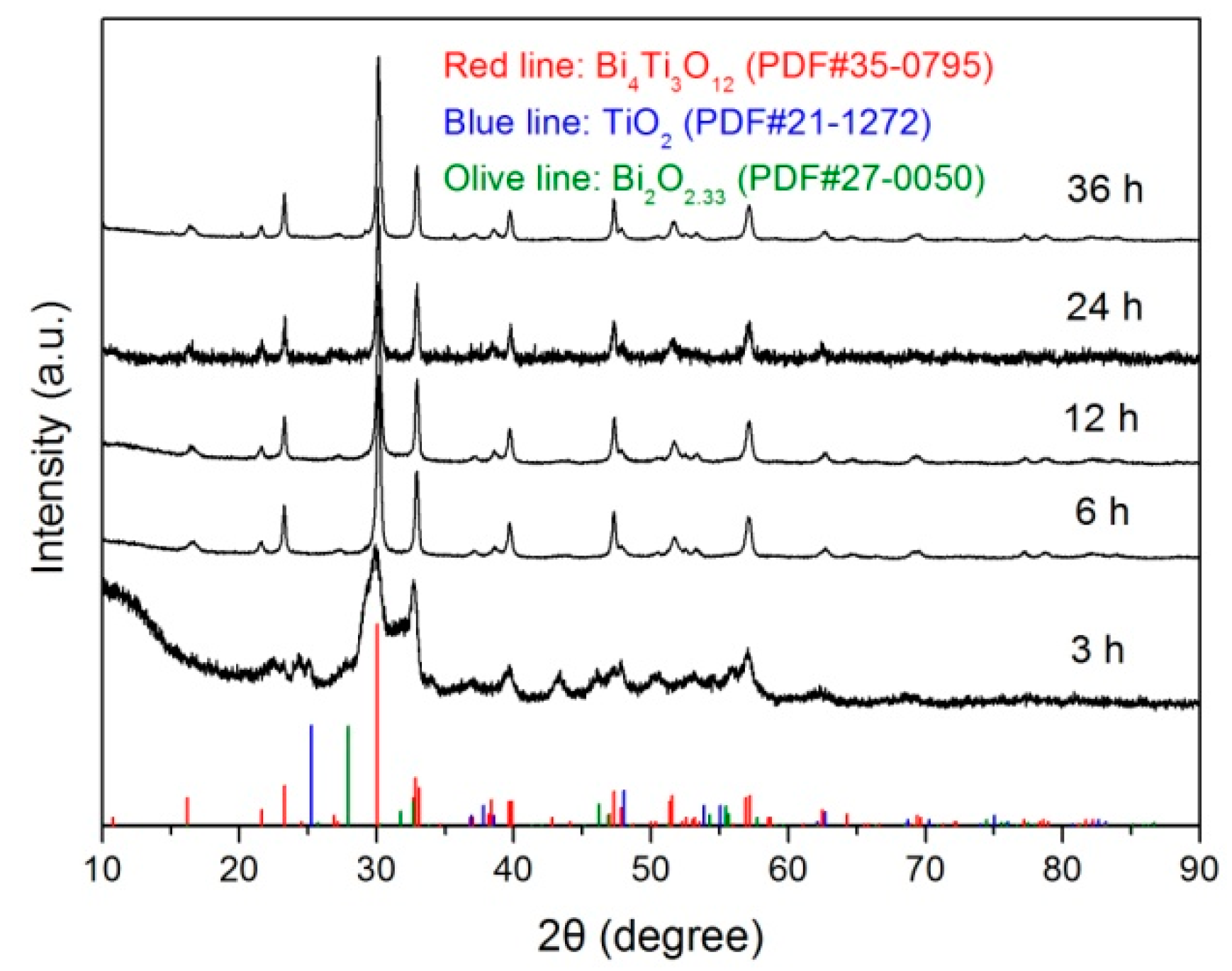
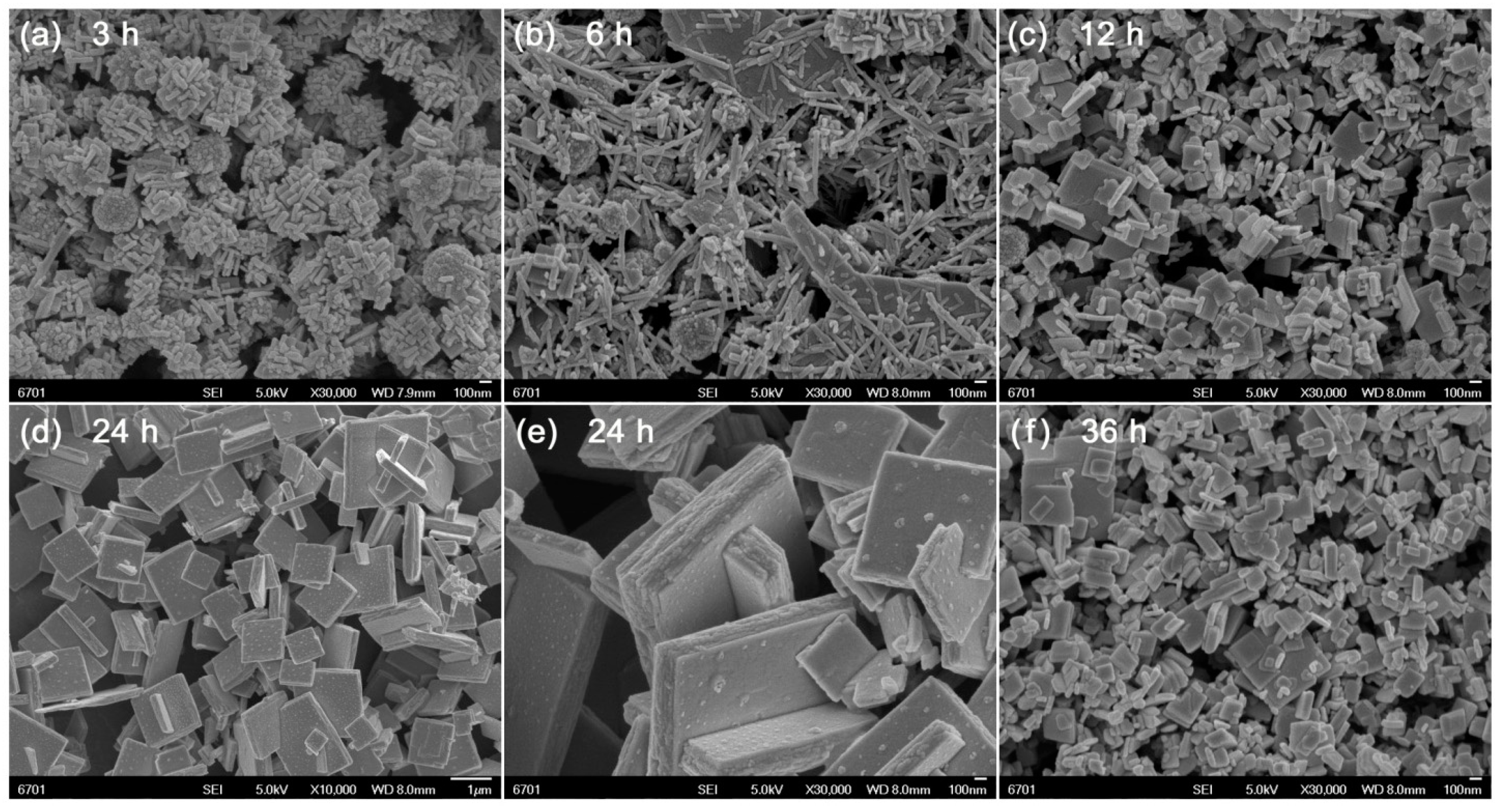
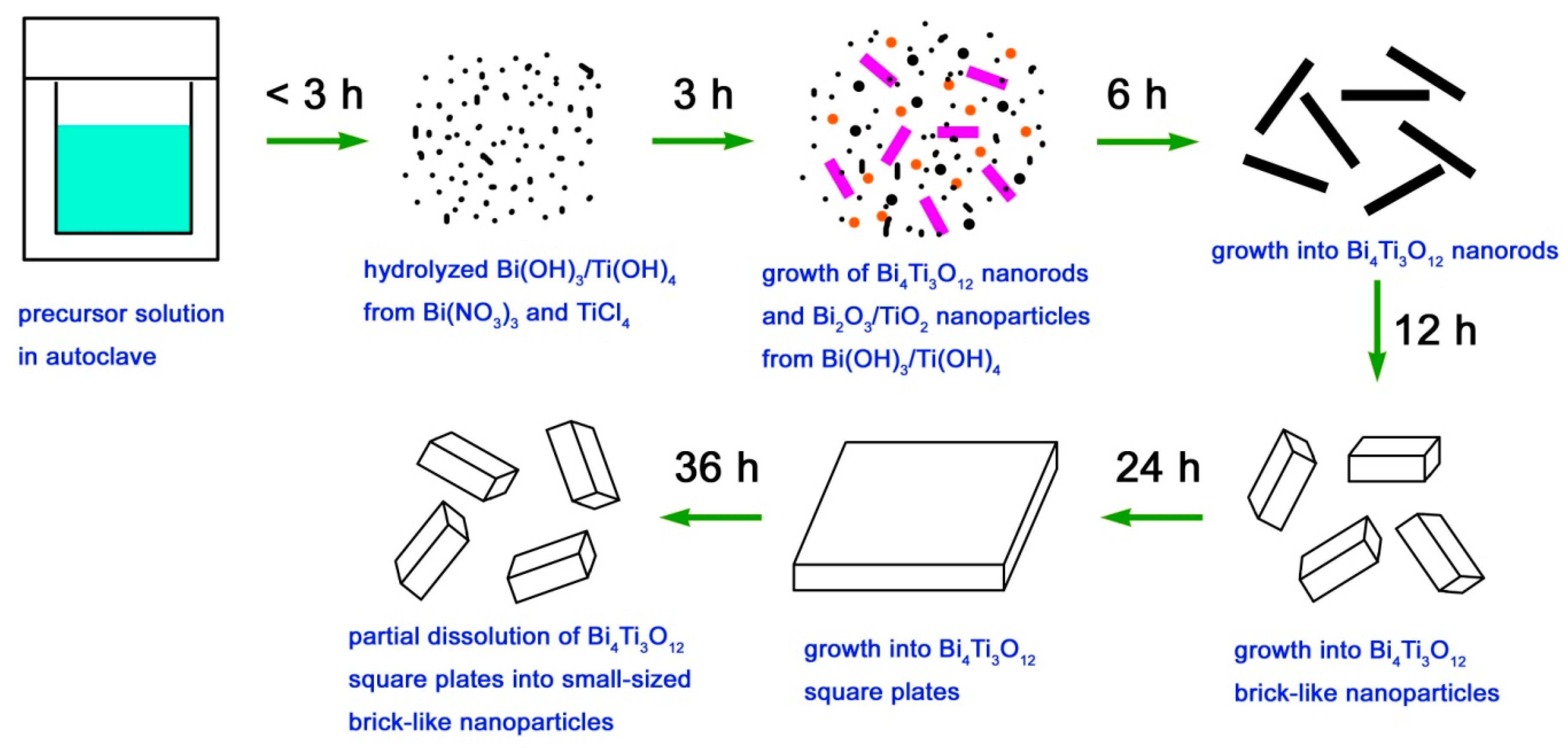
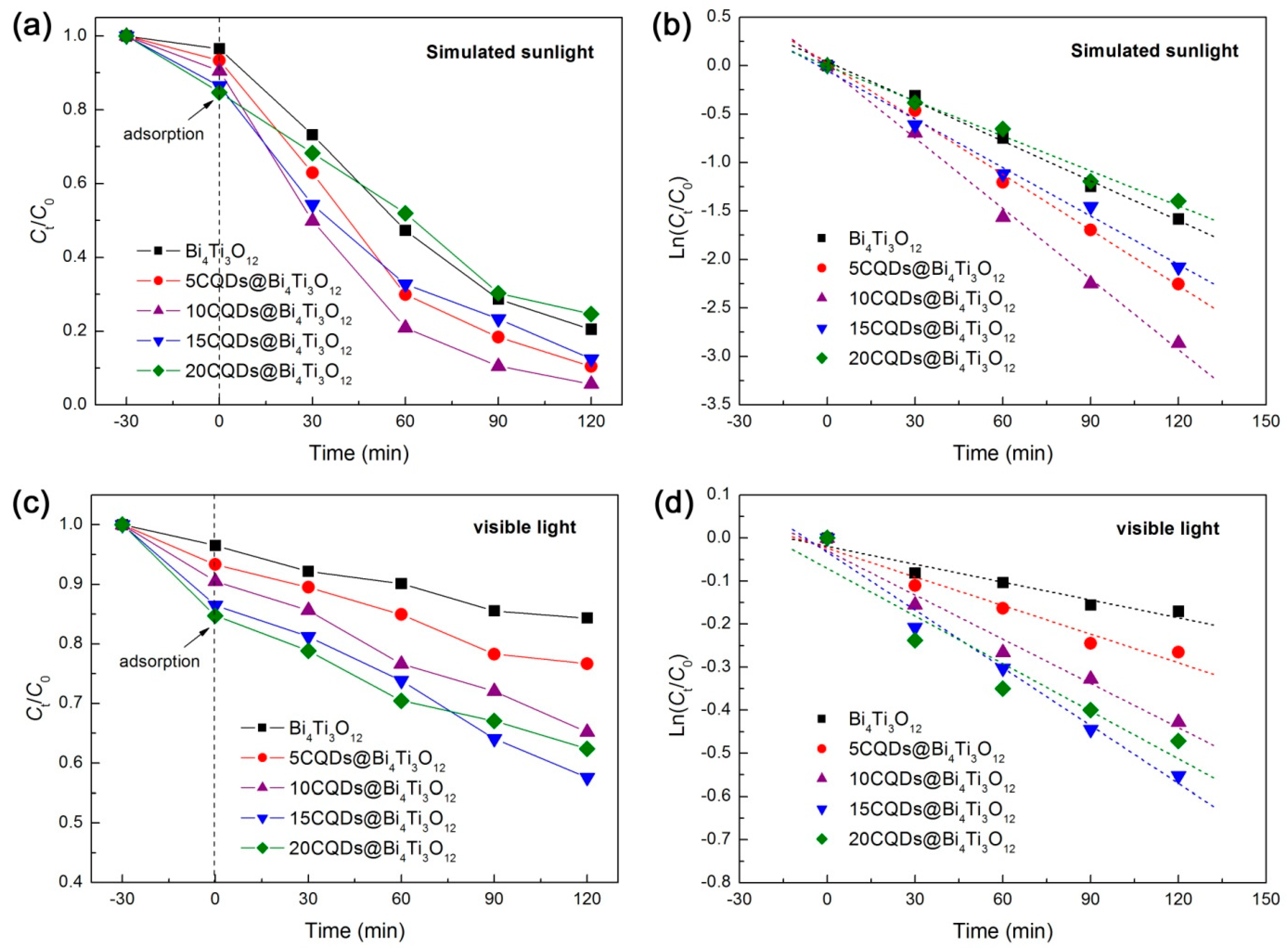
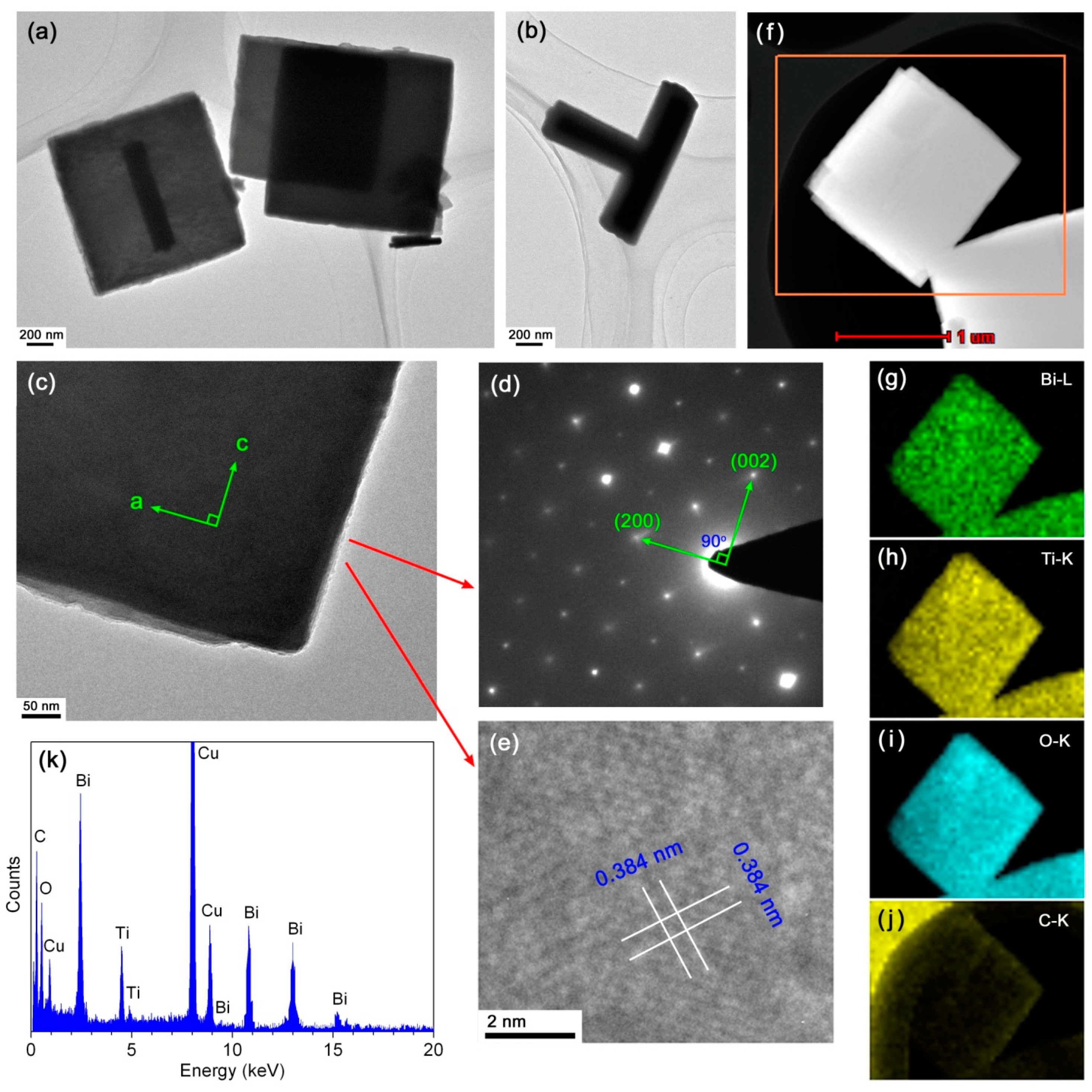
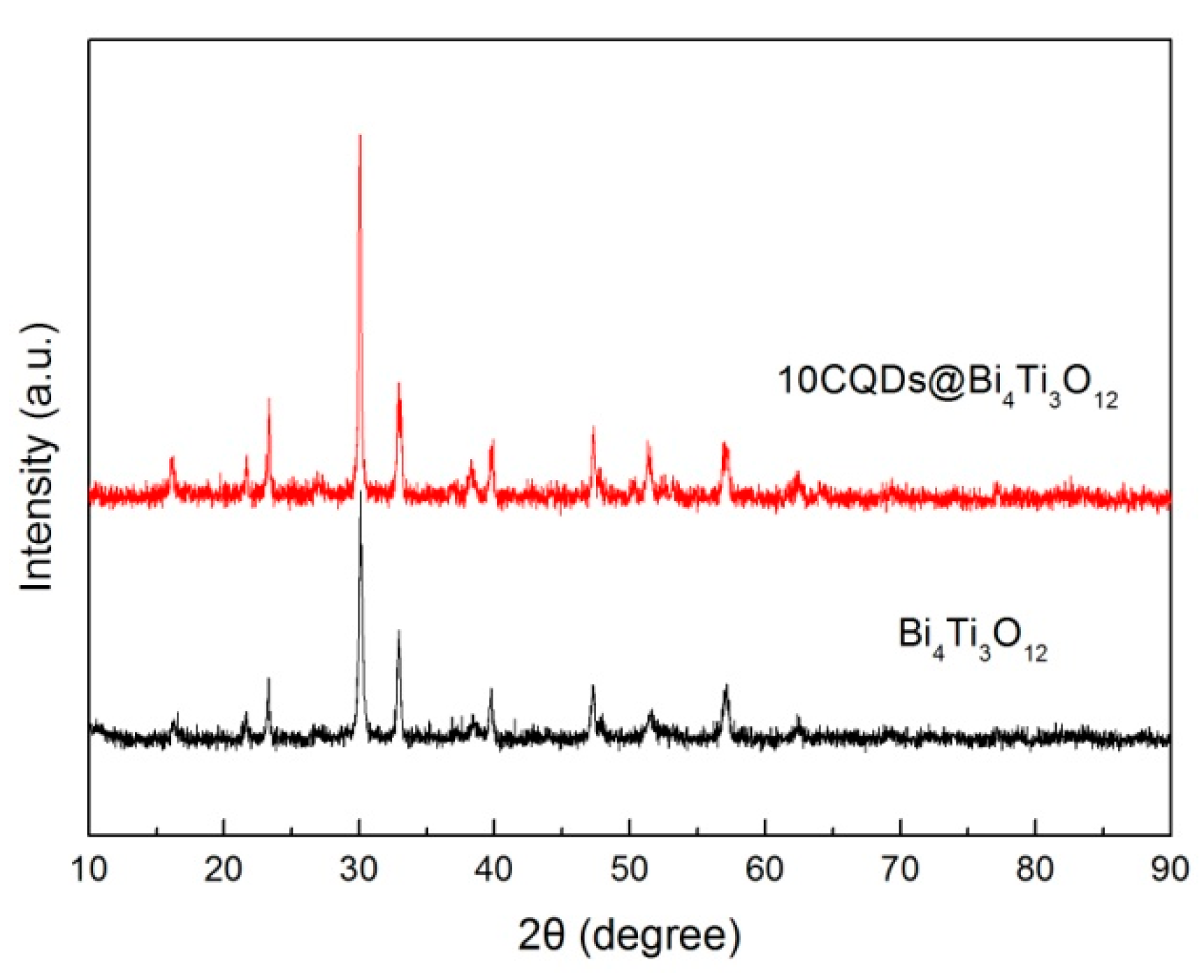
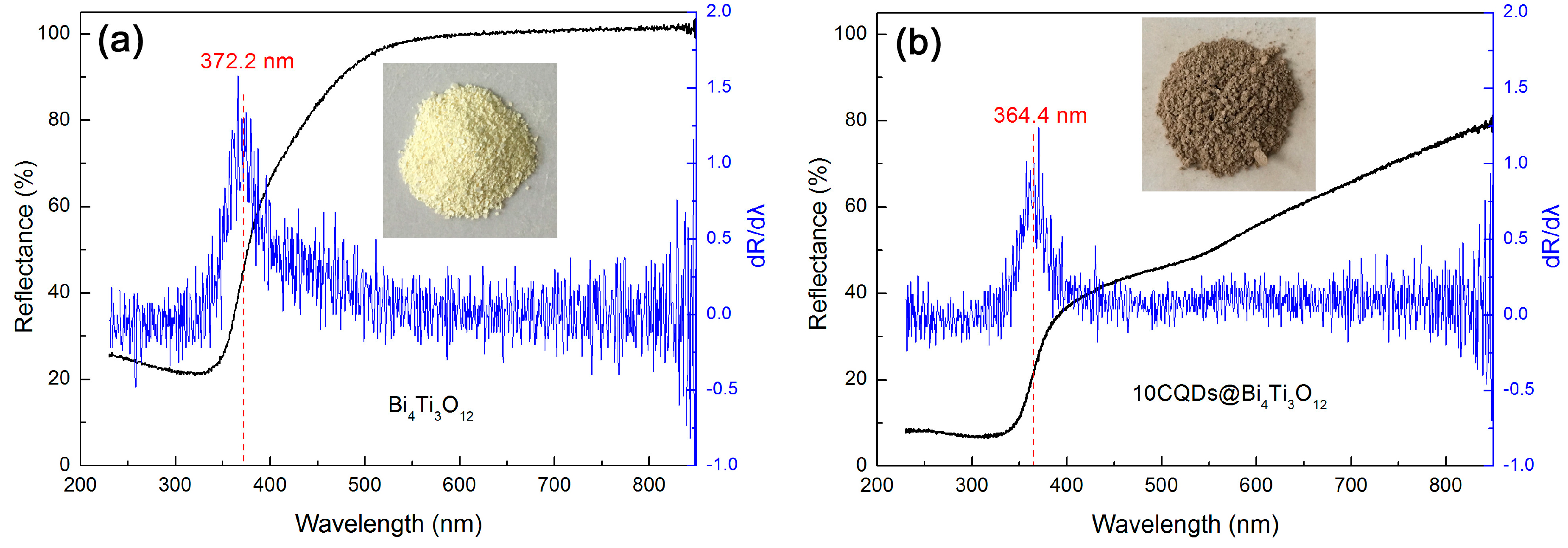
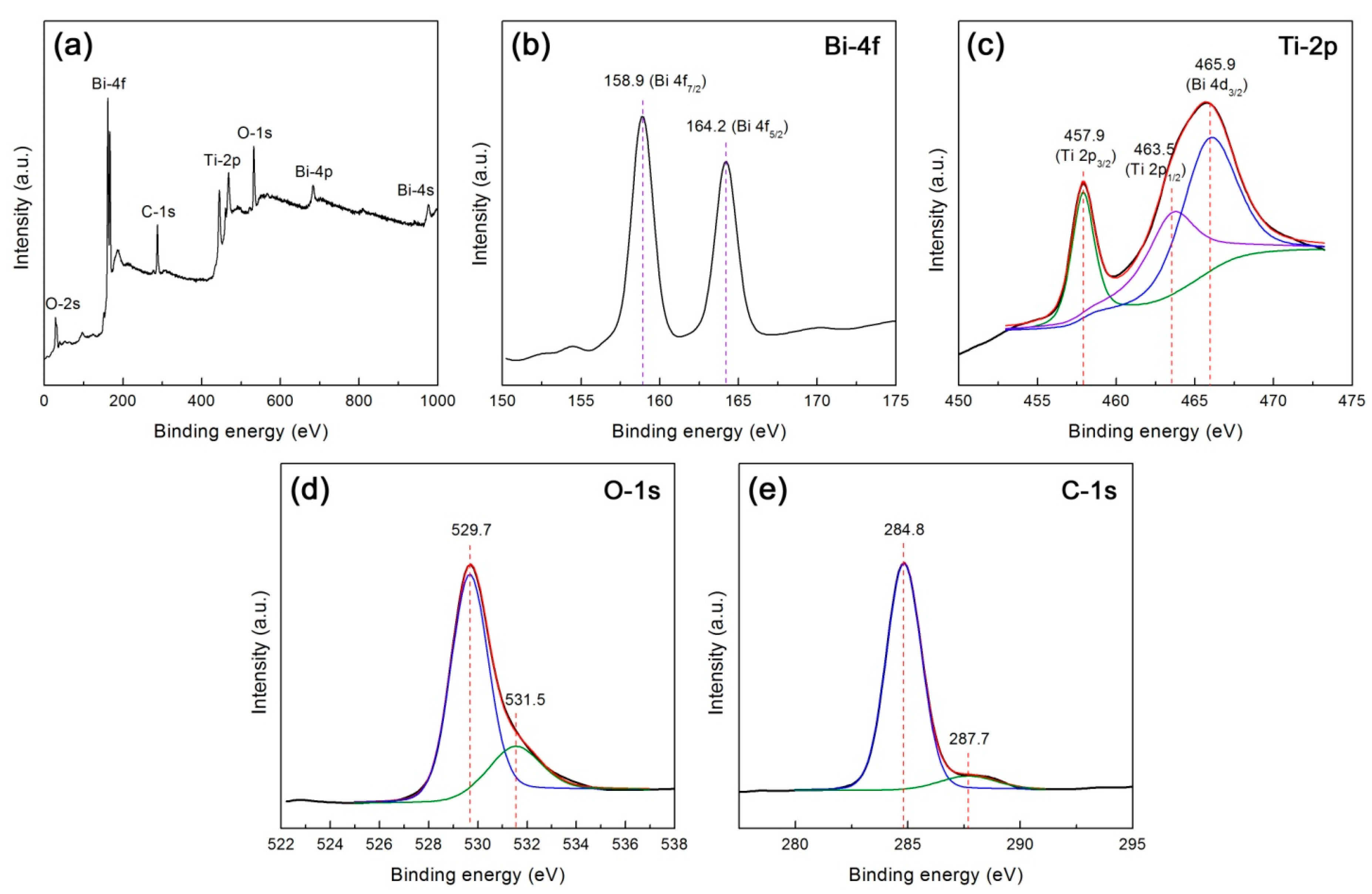
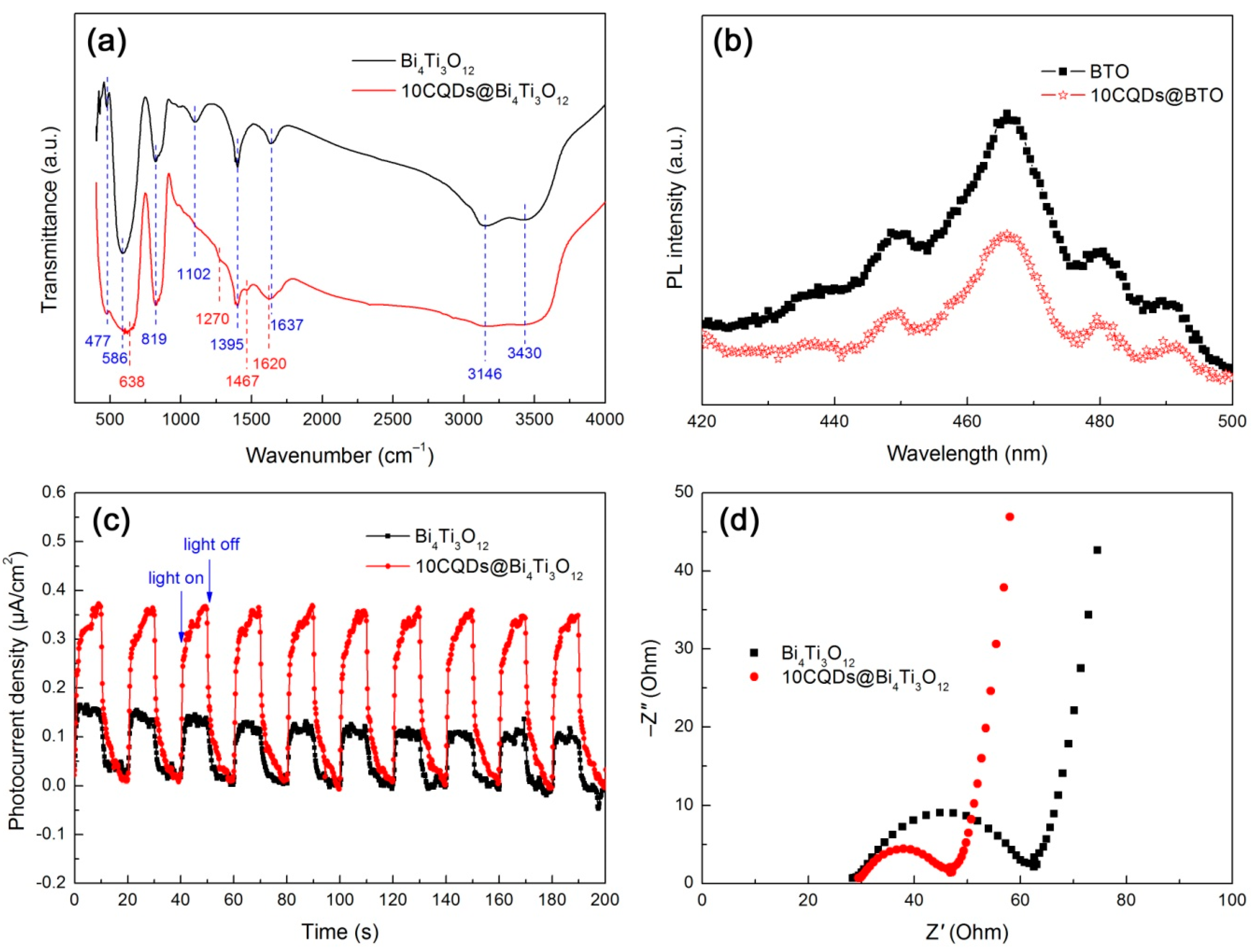
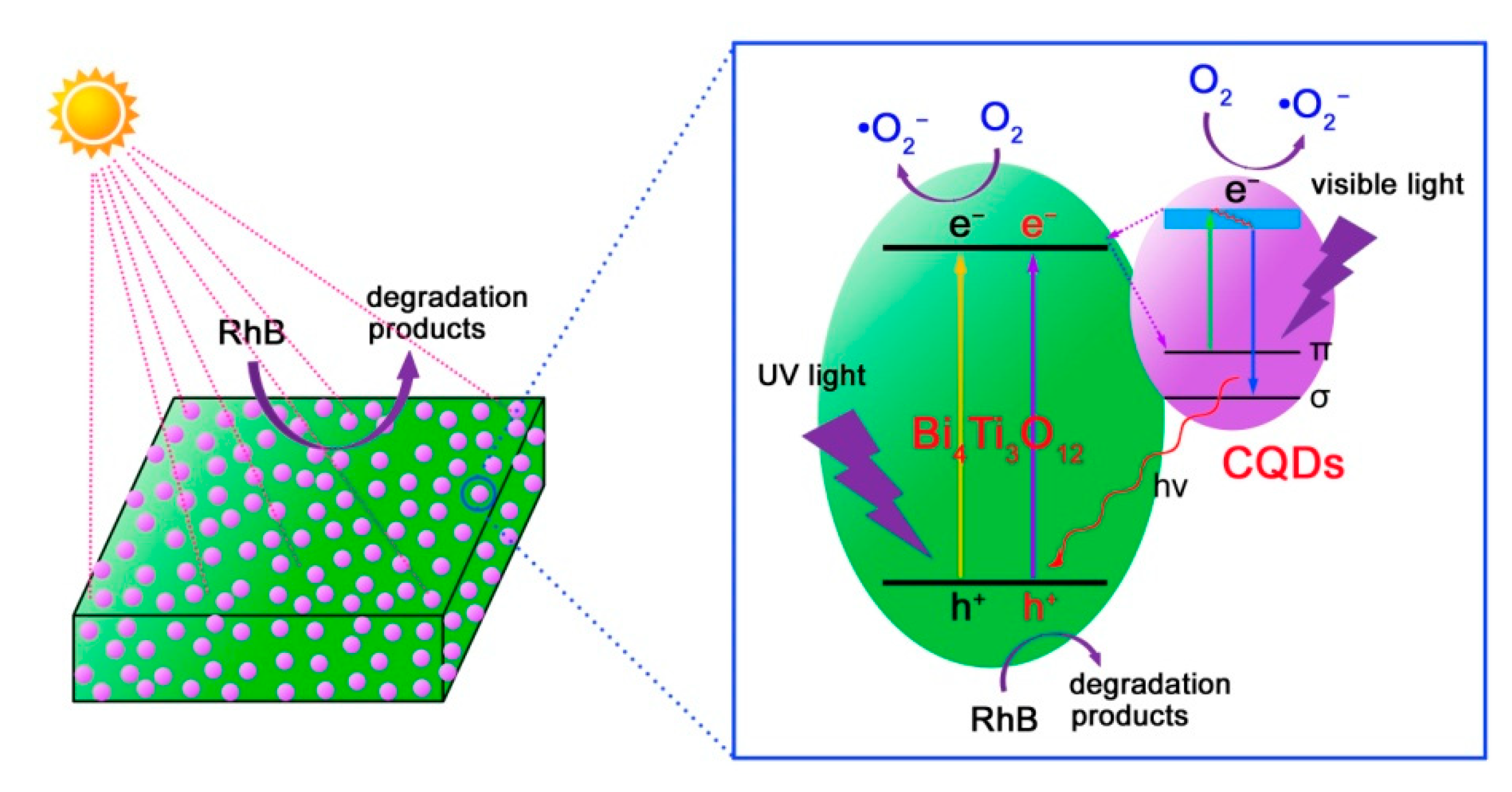
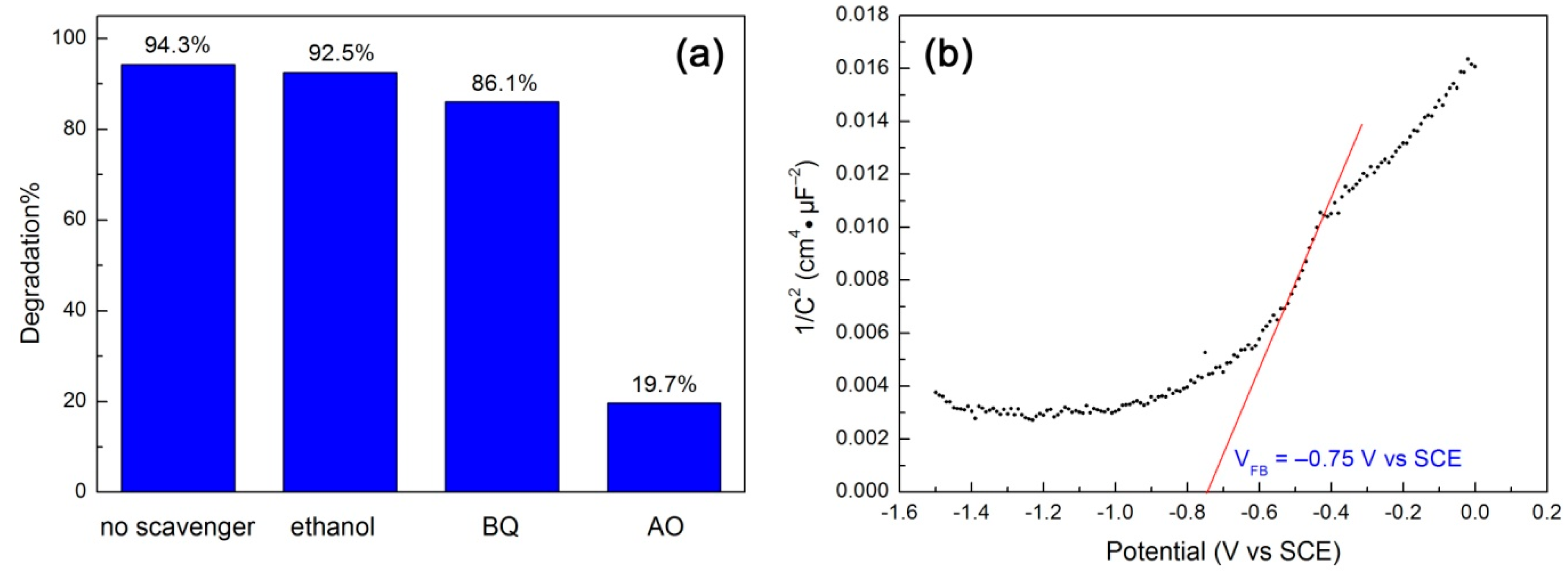
| Samples | Simulated Sunlight | Visible Light | ||
|---|---|---|---|---|
| Degradation (%) | kapp (min−1) | Degradation (%) | kapp (min−1) | |
| Bi4Ti3O12 | 79.5 | 0.01368 | 15.7 | 0.00139 |
| 5CQDs@Bi4Ti3O12 | 89.5 | 0.01912 | 23.3 | 0.00222 |
| 10CQDs@Bi4Ti3O12 | 94.3 | 0.02426 | 34.8 | 0.00342 |
| 15CQDs@Bi4Ti3O12 | 87.5 | 0.01667 | 42.4 | 0.00447 |
| 20CQDs@Bi4Ti3O12 | 75.3 | 0.01203 | 37.6 | 0.00368 |
© 2019 by the authors. Licensee MDPI, Basel, Switzerland. This article is an open access article distributed under the terms and conditions of the Creative Commons Attribution (CC BY) license (http://creativecommons.org/licenses/by/4.0/).
Share and Cite
Zhao, X.; Yang, H.; Cui, Z.; Wang, X.; Yi, Z. Growth Process and CQDs-modified Bi4Ti3O12 Square Plates with Enhanced Photocatalytic Performance. Micromachines 2019, 10, 66. https://doi.org/10.3390/mi10010066
Zhao X, Yang H, Cui Z, Wang X, Yi Z. Growth Process and CQDs-modified Bi4Ti3O12 Square Plates with Enhanced Photocatalytic Performance. Micromachines. 2019; 10(1):66. https://doi.org/10.3390/mi10010066
Chicago/Turabian StyleZhao, Xinxin, Hua Yang, Ziming Cui, Xiangxian Wang, and Zao Yi. 2019. "Growth Process and CQDs-modified Bi4Ti3O12 Square Plates with Enhanced Photocatalytic Performance" Micromachines 10, no. 1: 66. https://doi.org/10.3390/mi10010066
APA StyleZhao, X., Yang, H., Cui, Z., Wang, X., & Yi, Z. (2019). Growth Process and CQDs-modified Bi4Ti3O12 Square Plates with Enhanced Photocatalytic Performance. Micromachines, 10(1), 66. https://doi.org/10.3390/mi10010066






